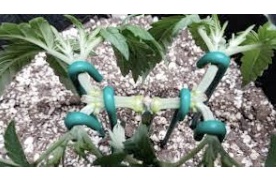Cannabis high stress training (HST) is a growing technique used to manipulate the growth pattern of a cannabis plant to increase its yield and produce bigger, bushier plants. The goal of HST is to stress the plant in a controlled way so that it responds by growing more branches and buds.
What is the difference between LST and HST cannabis?
LST (low stress training) and HST (high stress training) are two different techniques used to manipulate the growth of cannabis plants to increase yields and improve overall plant health. The main difference between LST and HST is the level of stress applied to the plant.
LST involves gently bending and tying down the branches of the plant to encourage them to grow horizontally. This technique is considered low stress because it doesn’t involve cutting or breaking any part of the plant. Instead, LST works by directing the growth of the plant to promote more even canopy growth, increase light exposure to the lower branches, and promote the development of multiple colas (flowering sites). LST is typically performed during the vegetative stage of growth and is considered a gentler and less risky technique than HST.
HST, on the other hand, involves physically stressing the plant in a more aggressive manner. HST techniques such as topping, fimming, super cropping, and ScrOG involve cutting or bending the plant in a way that creates a significant level of stress. These techniques are typically used to promote even canopy growth, increase the number of colas, and maximize light exposure to the plants. HST can be effective for increasing yields, but it can also be risky and stressful for the plant, and requires more experience and skill to perform correctly.
What are the most popular methods of HST training?
The three most commonly used methods of HST are fimming, topping and super cropping.
Topping: This involves cutting off the top of the main stem, which causes the plant to grow two new branches at the site of the cut.
Fimming: This is similar to topping, but instead of cutting off the entire top of the plant, only a portion of it is removed, which leads to the growth of four new branches.
Super cropping: This involves bending the stems of the plant until they almost break, which causes the plant to produce more branches and buds in response.
HST can be a useful technique for experienced cannabis growers who are looking to increase their yields, but it should be done with care because it can also be stressful for the plant and damage yields if it is not done correctly.
Can you use high stress training with autoflowers?
Yes, high stress training (HST) techniques can be used with autoflowering cannabis strains, but it’s important to use caution and choose the right methods.
Autoflowering strains have a shorter vegetative stage and a predetermined life cycle, so any stress placed on the plants could potentially affect their growth and yield. In addition, since autoflowers flower automatically based on age, HST techniques should be applied earlier in the plant’s life cycle, usually during the first few weeks after germination.
Some HST techniques, such as fimming or topping autoflowers, may not be suitable as they can delay or stunt the growth of the plant. However, other techniques such as LST (low stress training) and super cropping can be used to increase yields and promote even canopy growth without harming the plant.
LST involves gently bending and tying down the branches of the plant to encourage them to grow horizontally, while super cropping involves carefully bending the stems to create new growth nodes. These techniques can be effective with autoflowering strains as long as they are performed carefully and early in the plant’s life cycle. It’s important to research and understand the specific needs and characteristics of the autoflowering strain being grown before attempting any HST techniques.
How much more can you expect to yield using high stress training with cannabis?
The increase in yield that can be achieved through high stress training (HST) with cannabis will depend on several factors, including the strain being grown, the specific HST techniques used, and the skill and experience of the grower.
In general, HST techniques are used to promote more even canopy growth, increase the number of colas (flowering sites), and maximize light exposure to the plants, all of which can lead to higher yields. Some growers have reported increases in yields of up to 30% or more although this really depends on the experience of the grower.
When should you start high stress training?
The ideal time to start high stress training (HST) with cannabis will depend on the specific HST technique being used and the stage of growth of the plant.
In general, HST techniques should be started during the vegetative stage of growth, when the plant is still producing new leaves and branches and before it begins to flower. The exact timing will depend on the strain being grown, but most growers start HST techniques when the plant has developed 3-5 nodes (sets of leaves).
Some HST techniques, such as topping and fimming, are more aggressive and should be performed earlier in the plant’s life cycle to allow time for recovery and new growth. Other techniques, such as LST (low stress training) and super cropping, can be performed later in the vegetative stage when the plant has developed more branches and is better able to handle the stress.
Can you use high stress training on any autoflowers?
As we have mentioned some HST training methods such as topping can be done on autoflowers, however due to the stress they put the plant under it does pose a risk because of the short vegetative stages of autoflowers. Autos go from seedling to flowering within four weeks, leaving little to no time for recovery. However, sativa autoflowers do have slightly longer flowering stages and actually continue to grow while they are flowering. So if you are going to top an autoflower make sure it is a sativa with a longer flowering time to give yourself the best possible chance of success.




















